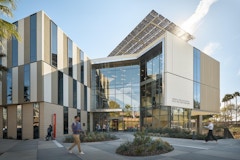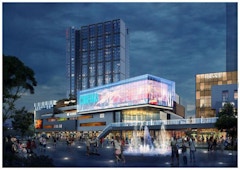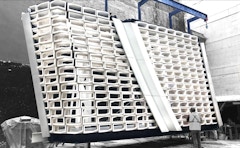
69 results
-
 Glass is a key component in building design. Benefits of utilizing Insulating Glass Units (IGUs) within a building facade are well understood,…
Glass is a key component in building design. Benefits of utilizing Insulating Glass Units (IGUs) within a building facade are well understood,… -
Collaborative Methodology for Fastracking Challenging Facade Concepts
- Paper by Stuart Berriman · Peter Simmonds, Ph.D., FASHRAE, FIBPSA, FFTI
The goal is to explore the role and methodology employed between the architect and engineer as they look to resolve the opposing demands of design
-
Carbon-Neutral High-Rise Envelope Nexus
- Paper by Thomas Spiegelhalter
The pathway to carbon-neutrality, as urged during the COP 21 in Paris, and the repeated goal for resilient buildings and urban habitats, winds right
-

Passive House Facade Design and Construction
- Paper by Louis Koehl, AIA, CPHD, Project Architect
Buildings account for over 40% of global emissions (GlobalABC, 2018). Growing populations and higher standards of living are increasing pressure on… -
A Compact, Unitized Double Skin Facade
- Paper by Alex Cox, LEED AP · James Hock, LEED AP BD+C · Laura Ziegler · Karin Lamberts
Driven by an increasing demand for high thermal and acoustic performance, transparency, and low maintenance costs, a number of facade innovations
-

Designing with Photovoltaics
- Paper by Wayne Walker · Julia Ragragio Ruiz, LEED AP BD+C · Sam Crawford
Photovoltaics (PV) have been utilized in buildings for decades, especially in Europe where legislative support has largely driven the market. With
-

Lightning Protection as Building Envelope
- Paper by Jennifer Morgan · Michael Chusid, RA FCSI CCS
A building’s envelope mitigates the effects of meteorological phenomena – including lightning – upon the structure and its occupants and contents.
-

Corrugated-geometry Copper and Glass Facade
- Paper by Marko Tomsic, PE, Project Consultant John A. Jackson, AIA, Senior Project Manager
The subject of this case study is the design and construction of a custom corrugated-geometry facade featuring pre-patinated copper and glass for an… -

Ginza Six
- Paper by Katsuhiko Muramoto · Junko Owada
Tokyo’s prestigious Ginza District, is home to innovative architectural design. One of the most recent examples is Ginza Six (GSIX), the largest
-

Heat-actuated Auxetic Facades
- Paper by Amira Abdel-Rahman · Elnaz Tafrihi
Highly transformable materials can be used as adaptive exterior shading systems by leveraging the relationship between external stimuli (heat) and
-
Facade Embodied Carbon Reduction Strategies
- Paper by Isabelle Hens, LEED AP BD+C, WELL AP
Facades are increasingly being recognized as a major contributor to whole-building embodied carbon. While designers know how to reduce the embodied
-

Anisotropic Effects in Architectural Glass
- Paper by Luis M. Hidalgo, Michael Elstner,
Iridescence effects, quench marks, leopard marks… The names given to optical anisotropy in toughened and heat-strengthened glass are diverse and… -
Reinforced Polymer Concrete Screen Walls
- Paper by Brock DeSmit · Jessica Hong · Becher Eli Neme
Apertures is a six-story, commercial building in the Roma Norte neighborhood of Mexico City–a neighborhood severely impacted by the 1985 and 2017
-

Fire Safety and Code Challenges for Mass Timber in Curtain Wall Systems
- Paper by David Barber · John Neary · Mic Patterson PhD LEED AP+
With the desire for more sustainable construction and reduced embodied energy, mass timber is being explored for building structures. For medium and
-

Facade Mock-ups
- Paper by Andy Lang, AScT, Principal / Facade Specialist
Curtain walls and window walls are typically specified to meet a variety of different performance and testing criteria, some of which can be quite… -
Sustainable simplicity and the future of exterior wall for research and education buildings
- Paper by Carl Knutson, AIA - Principal, Design Director Andrei Koshelev, dipl. Arch. SIA AIA - Head of Asset Management
Today, there is a shift towards sustainable simplicity in facades, embracing material innovations and thermal design strategies for long-term… -

Design Principles For Museum Daylight Systems
- Paper by Edgar Stach, PhD · Michael Esposito
This research unlocks the relationship between space, structure and light in nine unique museums developed by architect Renzo Piano. Renzo Piano uses
-

The Double Skin Facade
- Paper by Lee A. Fithian, AIA, AICP, NCARB, LEED AP,
The largest source of air pollution in North America is the atmospheric boundary layer of a city caused by its urban canyons with pollutants produced… -
Novel Techniques for Facade Optimization
- Paper by Viktoria Henriksson
Complex freeform architectural enclosures are becoming increasingly popular and easy to model and design with the help of modern computational tools.
-

Carbon-Dioxide-Inhaling Facade
- Paper by Prof. Dr. Timo Schmidt · Carmen Herrmann · Dr. Michael Lakatos · Daniel Zabicki · Prof. Dr.-Ing. Michael Wahl · Kai Scherer
3.5 billion years ago, cyanobacteria created the foundation for life on Earth by producing the oxygen basis for our atmosphere. Should we once again



